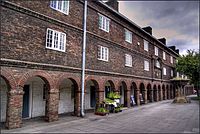Holy Jesus Hospital

Front of the Holy Jesus Hospital by David Ord
|
|
| Established | 2000 (in current form, see article) |
|---|---|
| Location | Newcastle upon Tyne |
| Coordinates | 54°58′17″N 1°36′28″W / 54.9715°N 1.6078°W |
| Type | Almshouse |
| Website | NT Website |
The Holy Jesus Hospital is a working office Newcastle upon Tyne, England, in the care of the National Trust.
The site of the hospital has been in use for 700 years helping the townspeople. There was an Augustinian friary on the site from the thirteenth century, then an almshouse for housing retired freemen, then a soup kitchen was built next to Almshouse in the nineteenth century, before the site acquired its current function as a working office. The building also serves as the basis of the Inner City Project of the National Trust. This project takes people of ages 12–25 and over 50 out to the countryside in order to increase appreciation of the city's natural surroundings.
The building is of architectural interest because it still retains architectural elements from many previous centuries, including a 14th-century sacristy wall and 16th-century tower connected with the King's Council of the North. It is also one of only two intact 17th-century brick buildings that survive in the city, the other being Alderman Fenwick's House.
In the 13th century, Newcastle upon Tyne had a population of around 4,000; and it was difficult for the four parish churches to care for the needs of such a large population. The priests were expected to be educators, doctors and counsellors, as well as meeting the spiritual needs of their parishioners. Therefore, in 1291 land was donated by William Baron of Wark on Tweed to found an Augustinian friary on the land on which the museum now stands.
The Augustinian Friars were originally an order of hermits in northern Italy who Pope Alexander IV first congregated into a single body in 1256. The Order spread to France and then to England after being invited by Richard de Clare, 6th Earl of Hertford, to found Clare Priory in Suffolk, by the River Stour. On 3 September 1249, de Clare was able to obtain a writ of protection for the friars from the King. The brethren were clothed in black and observed the rule of St Augustine of Hippo. Augustianian friars had been in England since 1250 and they helped by preaching and healing in the community.
...
Wikipedia
